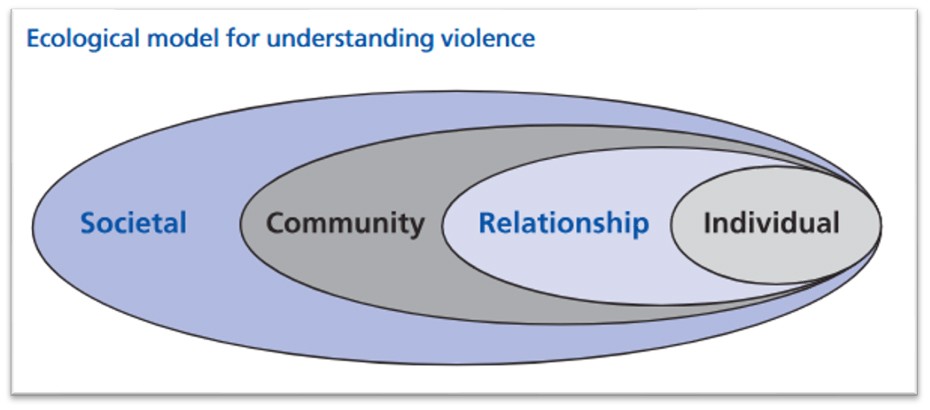Risk and/of Violence
 Image credit: Krug, Etienne, Linda Dahlberg, James Mercy, Anthony Zwi and Rafael Lozano (Eds). 2002. World Health Report on Violence and Health. Geneva: World Health Organization, p. 12 (online at: https://www.who.int/publications/i/item/9241545615)
Image credit: Krug, Etienne, Linda Dahlberg, James Mercy, Anthony Zwi and Rafael Lozano (Eds). 2002. World Health Report on Violence and Health. Geneva: World Health Organization, p. 12 (online at: https://www.who.int/publications/i/item/9241545615)
About their research
We are interested in the murky relationship between risk and violence. We ask what the antecedents of violence might be, how they can be detected, and how societies should organize to intervene in them in order to prevent violence. We also ask what it means to act in a pre-emptive, risk-managing way against the seeds of violence.
Popular culture has provoked sustained reflection on these questions. Philip K. Dick’s novella The Minority Report featured ‘precogs’ who could glimpse future crimes. The dystopic underside of a supposedly utopic society where police intervene in ‘precrime’ becomes evident as the protagonist finds himself a suspect in a system designed to convict and incarcerate in advance of the actus reus.
Social studies of risk, however, have always had a vexed relationship with studies of violence. Risk is widely understood to be different from the event it is supposed to precede. When violence happens, we are no longer dealing with risk of violence, but with violence itself. How then should social studies of risk engage with violence today?
It is tempting to assume that violence is proliferating, especially when looking at the scale of current conflicts or the rising profits of arms and munitions manufacturers. But such examples may reflect, instead or in addition, a shifting global landscape in which the forms, visibility, and framing of violence are changing. We also need to think about diverse forms of material and symbolic violence in peoples’ everyday lives, which may differ depending on social location. The World Health Organization has, for example, developed a typology of violence, distinguishing between self-directed, interpersonal, and collective violence. Within this typology, violence, much like risk, could be found anywhere.
If this is so, how should we think about different kinds of violence (and different kinds of risks of violence)? Why, and how, should we distinguish between risk and violence? And are certain kinds of risk or violence more deserving of our attention?
Key questions
- How should societies organize, for example, to intervene in the antecedents of violence, to prevent violence from happening?
- What does it mean to act in a pre-emptive, risk-managing way against the seeds of violence?
- How should social studies of risk engage with violence today?
Team
Martin French
Department of Sociology & Anthropology
Ketra Schmitt
Centre for Engineering in Society
Amy Swiffen
Department of Sociology & Anthropology
Group members
Valérie De Courville Nicol
Department of Sociology and Anthropology
Gilbert Émond
Department of Applied Human Sciences (Faculty)
Martin French
Department of Sociology & Anthropology (Faculty)
Kayla Genereux
Department of Sociology & Anthropology (Student)
Nazila Hoche Abdi
Department of Electrical and Computer Engineering (Student)
Jochen Jaeger
Department of Geography, Planning and Environment (Faculty)
Sylvia Kairouz
Department of Sociology & Anthropology (Faculty)
Marc Lafrance
Office of the Provost (Faculty)
Ketra Schmitt
Centre for Engineering in Society (Faculty)
Amy Swiffen
Department of Sociology & Anthropology (Faculty)
Matthew Unger
Department of Sociology & Anthropology (Faculty)
Bugra Yalin
Department of Sociology & Anthropology (Student)
Coordinators
Chelsea Harvey Garner
Email: ChelseaHarveyGarner@gmail.com
Bugra Yalin
Email: bugra.yalin@mail.concordia.ca

